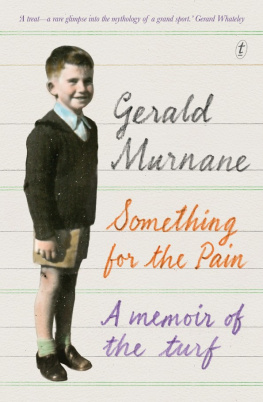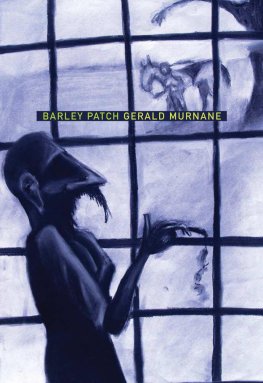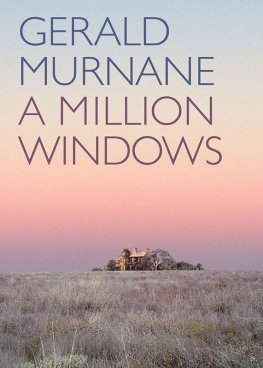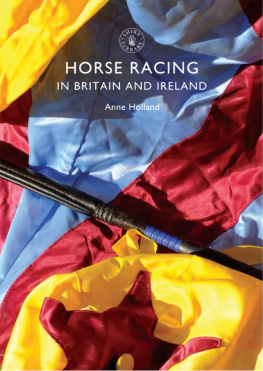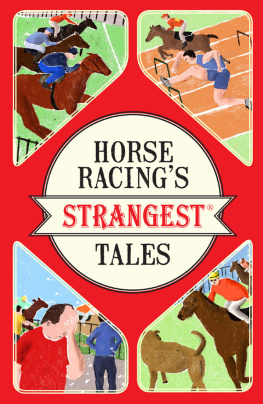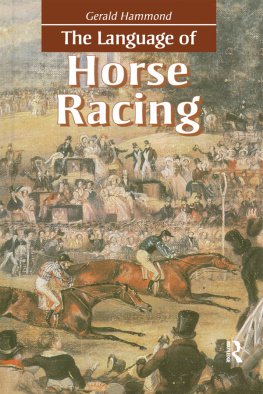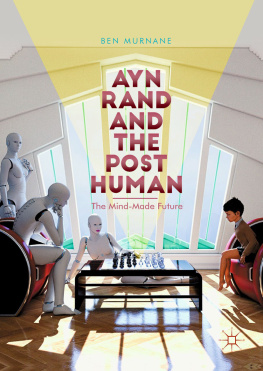

PRAISE FOR GERALD MURNANE
Something for the Pain is Gerald Murnane at his best. His meticulous exploration of his lifelong obsession with horse racing is by turns hilarious, moving, and profound. If Australian writing were a horse race, Murnane would be the winner by three and a half lengths.
Andy Griffiths
Gerald Murnane is unquestionably one of the most original writers working in Australia today.
Australian
Murnane, a genius, is a worthy heir to Beckett.
Teju Cole
He is an artist of such rare and single-minded originalityas well as being the greatest sentence-maker Australia has ever seen.
Wayne Macauley
Murnane is a careful stylist and a slyly comic writer with large ideas.
Robyn Creswell, Paris Review
[ The Plains ] is a distinguished, distinctive, unforgettable novel.
Shirley Hazzard
Murnane is quite simply one of the finest writers we have produced. He is a master stylist.
Peter Craven
Gerald Murnane was born in Melbourne in 1939 and spent part of his childhood in country Victoria. He has been a primary teacher, an editor, and a university lecturer. His debut novel, Tamarisk Row , was followed by nine other works of fiction, the most recent of which is A Million Windows . He has also published a collection of non-fiction pieces, Invisible Yet Enduring Lilacs . Murnane has won the Patrick White Award, the Melbourne Prize for Literature, and the Adelaide
Festival Award for Innovation. He lives in western Victoria.
Also by Gerald Murnane
Tamarisk Row
A Lifetime on Clouds
The Plains
Landscape with Landscape
Inland
Velvet Waters
Emerald Blue
Invisible Yet Enduring Lilacs
Barley Patch
A History of Books
A Million Windows
textpublishing.com.au
The Text Publishing Company
Swann House
22 William Street
Melbourne Victoria 3000
Australia
Copyright Gerald Murnane 2015
The moral right of Gerald Murnane to be identified as the author of this work has been asserted.
All rights reserved. Without limiting the rights under copyright above, no part of this publication shall be reproduced, stored in or introduced into a retrieval system, or transmitted in any form or by any means (electronic, mechanical, photocopying, recording or otherwise), without the prior permission of both the copyright owner and the publisher of this book.
First published in 2015 by The Text Publishing Company
An earlier version of the first section appeared in Seizure
Cover & page design by W. H. Chong
Typeset in Granjon by J & M Typesetting
National Library of Australia Cataloguing-in-Publication entry
ISBN: 9781925240375 (paperback)
ISBN: 9781922253187 (ebook)
Creator: Murnane, Gerald, 1939 author.
Title: Something for the pain : a memoir of the turf / by Gerald Murnane.
Subjects: Murnane, Gerald, 1939. Authors, AustralianBiography.
Horse racing.
Dewey Number: 798.40092


Contents
MACHINERY AND TECHNOLOGY have always intimidated me. I did not dare to use a motor mower until I was in my fifties with sons old enough to help me start it. I bought a mobile phone fifteen years ago and have carried it ever since in the boot of my car. I make a call occasionally but have never even learned to store numbers in my machine. My previous car had a facility for playing audio tapes, and I succeeded in mastering it. However, the car that I bought four years ago plays only compact discs. I have a few discs that I listen to occasionally at home but not enough to warrant my struggling with the thing in my dashboard. I can use the radio in my car but, because I live in a remote district, I can pick up only a few stations and their programs fail to interest me. Luckily, I can pick up the station that broadcasts horse races from all over Australia and even, sometimes, from New Zealand. I still call the station 3UZ, although it acquired a fancy new name some years ago.
Only a few years ago, the Herald Sun published every day the fields and riders and form for every race meeting covered by the Victorian TAB. Nowadays, only a few meetings appear in print. No doubt the details of all the other meetings are available on some or another website, but a man who cant use the CD player in his car is hardly likely to be able to use computers. And so, when Im driving on some lonely road in the far west of Victoria and I switch on my car radio, the names of the horses in the race being described are likely to be names that Ive never seen in print. The course where the race is being run is likely to be far away in the vast part of Australia where Ive never been. What, then, do I see in mind while Im listening to a rapidly delivered report of the changing positions of horses unknown to me in a place Ive seen only on maps?
Writing has for me at least one advantage over speaking. While Im writing, I pause often to make sure that the words Im about to set down are truly accurate. I may have told someone in conversation that I often see in mind, while Im driving alone, a field of horses approaching a winning post at Gunnedah or Rockhampton or Northam. But Im not about to write that I see any such thing. I ought rather to write that a radio broadcast of a horse race brings to my mind a swarm of vague, blurred images, a few being images of horses with jockeys up but most having no resemblance to horses or jockeys. The images are accompanied by feelings, some easy to reportsuch as my willing one or another horse to winand others difficult indeed to describe.
Perhaps if I were a horseman, I would more easily call to mind the horses themselves while I listen to race broadcasts. I might even imagine the race from the viewpoint of a jockey with a straining, pounding horse beneath him. The fact is, though, that Ive never sat astride a horse, let alone urged it into a gallop or even a canter. During all the countless hours that Ive spent on racecourses, Ive never really looked at a horse. When I recall some of the famous horses that have raced in front of meTulloch, Tobin Bronze, Vain, Kingston Town, and the likeI see in mind no images of bays or browns or chestnuts or whatever, with distinctive heads or conformation. Instead, I might recall, for example, the finish of the first race that Tulloch won in Melbourne, on Caulfield Cup Day, 1956, or the newspaper pictures of his elderly owner during the weeks when the old fool dithered over Tullochs running in the 1957 Melbourne Cup. I would not fail to see an image of Tullochs racing coloursRed-and-white striped jacket, black sleeves and cap. I would see also the features of the jockey who often rode Tulloch, Neville Sellwood, the same man who deliberately stopped Tulloch from winning the 1960 Melbourne Cup, just as he stopped the favourite, Yeman, from winning the 1958 Cup. (I cant prove these claims, but for me they are facts of history.) As well as seeing these things in mind, I would feel again the feelings forever bound up with those remembered images. I might even become again for a moment the troubled young man that I was when Tulloch was racing. But I dont want to go there just now. Im supposed to be writing about my present self, alone in my car on an empty road and hearing a report of a field of unknown horses on some faraway racecourse.
Next page
